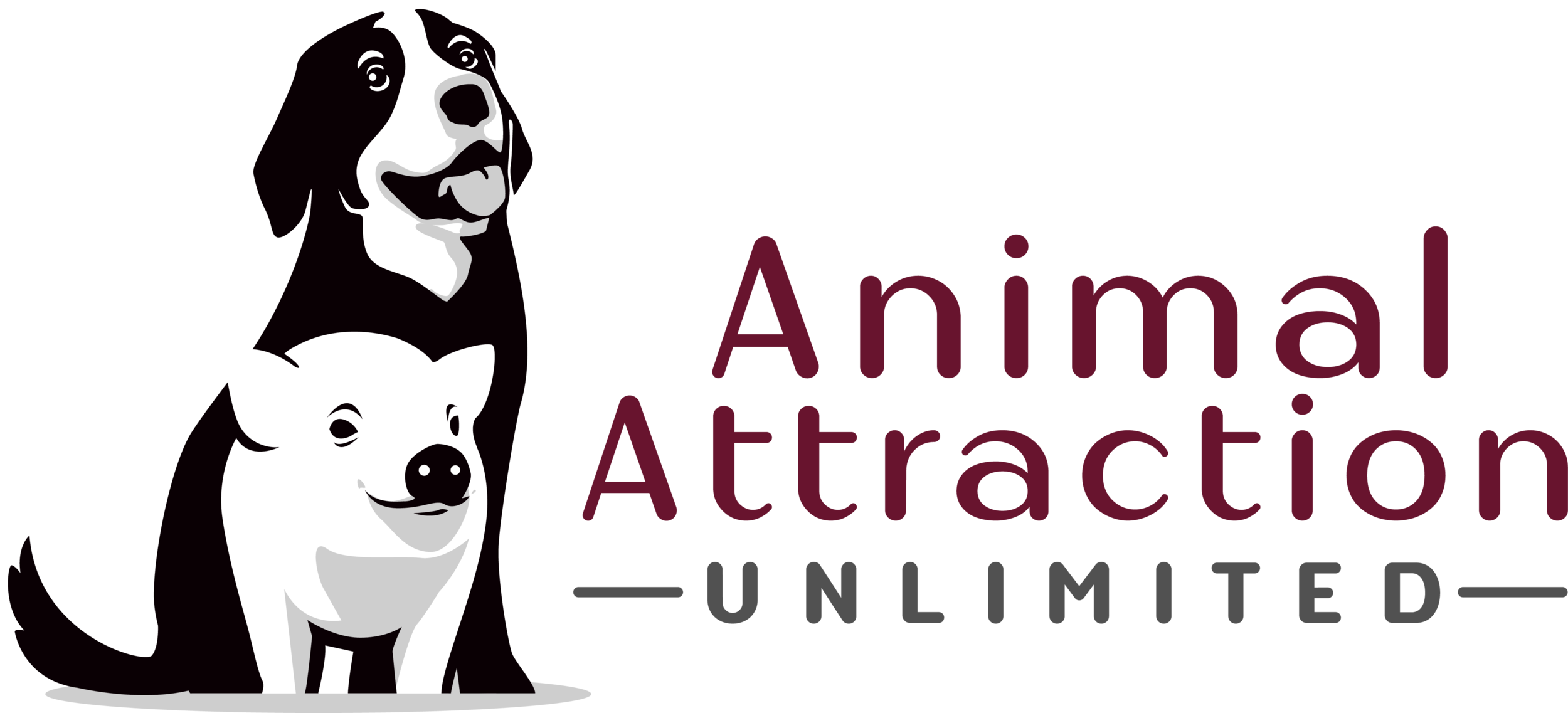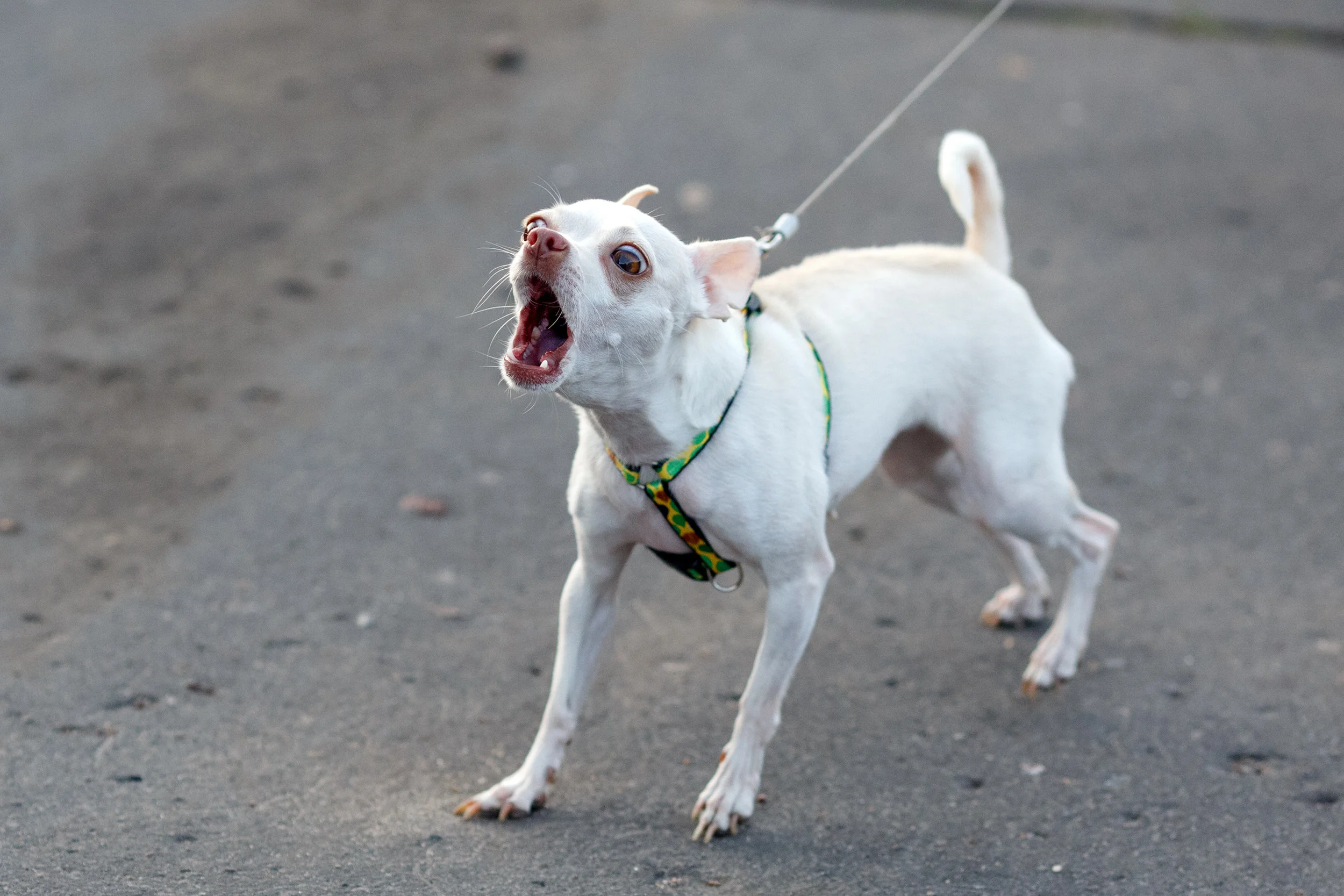Leash Reactivity
One of the calls I get most often is about dogs that are leash reactive and dog aggressive. This could mean they make noise, bark & lunge because they are happy to see the dog or person approaching, or it could mean they are not so happy to see what's coming towards them or behind a fence they are walking past. Sometimes the dogs themselves are conflicted and don't know what they want. Either way, it can be nerve wracking for both the person handling the dog as well as the subject at which the dog is reacting.
Leash aggression is often caused by what we call barrier frustration. It can also be seen by dogs behind fences or who are able to look out their front windows onto the street where they can bark at anything going past their house. Of course, if your dog is leash reactive and has the ability to see through your home's fence or out a window the first course of action is to block those views. Yes, they will still likely bark when they hear someone/something going by, but the duration and intensity of the reaction will be decreased. This in turn means it will be easier for you to call them away from the source, and it will also help to diminish their reactivity when on leash. Remember, if you can't control their behavior in the house or yard it's pretty much guaranteed you won't be able to control it outside the house.
This brings up an extremely important point about any kind of aggression. When dealing with a reactive dog always remember that distance is your best friend and ally. Think of it as gravitational pull. The closer you get to the earth's surface the greater the gravitational pull or acceleration. So, when dealing with a leash reactive dog, the closer you are the to subject the more difficult it will be to get your dog's attention. If you can't get his attention when you first see the subject approaching then stop moving towards the subject because it isn't going to get any easier. That's why when walking past homes where you know there are dogs behind fences you need to walk on the opposite side of the street. Once you can get your dog to pay attention to you from there don't just jump to the side of the street where the dog is, move in gradually. By gradually I mean inches, not feet. I know this is difficult on a busy street because most of the time it means you are in the street while training. If that's the case then I suggest you find a quiet street with dogs behind fences and very little traffic to practice on until you & your dog have the skills necessary to go back to a street on which you would normally walk.
This also applies to those who live in areas where the streets are narrow. Sometimes going across the street still isn't enough because the street just isn't wide enough to create the distance your dog needs. This can be a frustrating situation. In this case you have the option above, going to another area to walk & practice, or one thing I have people do during training is have their dog on the leash and just sit on their front porch or in their doorway and work their dog as the world goes past their house. This gives you the opportunity to create as much distance as needed, and you can stop the exercise when your dog is still paying attention to you by just going inside & closing the door, rather than getting stuck blocks away from home with a dog that is reacting to everything because he's hit a wall mentally.
Of course, with any of this training there needs to be foundation skills which the dog should be pretty good at in his home before taking it on the road. This means the dog should leave whatever he reacts to from inside the house when you tell him to, especially if you've put up visual barriers. Since dogs are visual creatures having visual stimulation really keeps the behavior going and means it will be tougher for you to call him away. Remember that gravitational pull? It's very strong when there is a visual component involved and it will be working against you every time.
Some of the foundational skills that are the most important when dealing with reactivity are basic training: sit, stay, wait, and leave it. These fall under what I consider to be impulse control exercises. They prevent the dog from doing what he wants and hopefully helps him pay attention to you. Most of them are obvious but I'd like to explain "leave it". For some people "leave it" is more like how I teach "wait", which is the dog must not do something for however long I determine and then they get to do it. Here's an example: you put your dog in a down-stay and place a piece of food in front of him saying "wait". He waits for however many seconds you choose and then you tell him to "take it". That's my "wait" command.
Here's what "leave it" means to my dogs. Plain and simple it means leave it alone, walk away, don't even bother because it's never going to happen; and it means look at me - instant eye contact. He never gets what he was looking at. See the difference? Leave it is what I use when my dog is looking at something and considering his options. If there's a fast food wrapper on the ground and my dog sees it I'll tell him to "leave it" and he not only moves away from it he looks at me. That is what he gets paid for - the eye contact. The payment could be praise, petting, food, a toy, whatever the dog would find as or more rewarding than the wrapper. To use this when dealing with a leash reactive dog you say, "leave it" as soon as your dog sees the other dog. Not when he is already reacting and committed to the behavior. Once your dog is committed to the behavior you will have a very difficult time getting his attention, so your goal is the interrupt his train of thought before he reacts to keep him from going to "the bad place". This is where creating distance will help you tremendously. You'll see over time that the distance will decrease and the next thing you know you'll be able to walk on the same side of the street as those dogs behind fences!
Many people ask how many sessions it takes to help a leash reactive dog and there really is no clear-cut answer for that. It depends entirely on the dog and how reinforcing he finds it to bark & lunge at other things, as well as how well and often you do your homework, but the foundation needs to be there before any progress can be made. Since there are multiple steps involved in working with this issue most often it takes more than one session to get you & your dog where you are comfortable working with him in any given situation. Then it takes time and practice. Sometimes it takes a lot of time, months to a year even, depending on your dog's reactivity level, how long he's been practicing the behavior, how often you work with him, how well you work with him (meaning are you doing everything right?) and if you are preventing him from being reactive in other situations. Rarely can leash reactivity be resolved with just one training session.
For more information on leash reactivity I highly recommend Patricia McConnell's booklet "Feisty Fido". Not only does it explain the "leave it" exercise but it also covers what to do in those emergency situations when something suddenly comes around the corner as well as other useful things. Also, my dear friend Kim Rinehardt & I have a podcast which specially addresses this issue. The name of our podcast is Doggie Dish, and the title to look for is "Shy, Fearful and Reactive Dogs" and can be heard on this website or downloaded from iTunes, Soundcloud and many other podcast players.
Laura Bourhenne
Animal Attraction Unlimited
Copyright 2011

